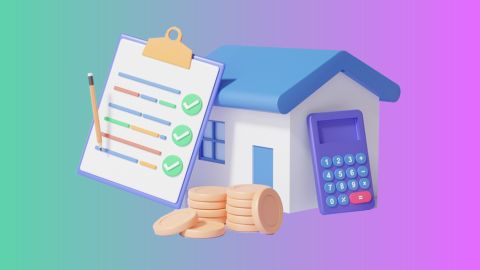A registered mortgage is a formal agreement in which the lender holds a legal interest in the borrower’s property until the loan is fully repaid. This type of mortgage is officially recorded with the relevant government authority, providing public notice of the lender's interest in the property. The registration process ensures that the lender’s claim takes priority over other claims on the property. This legal framework helps protect the lender's investment by ensuring that the property cannot be sold or transferred without their consent. Registered mortgages are common in real estate transactions and are crucial for securing large loans.
In the context of a loan against property (LAP), registering the mortgage provides the lender with added security by legally documenting their claim over the property used as collateral. This helps in safeguarding the lender's interest and ensures compliance with regulatory requirements.
What is a registered mortgage?
A registered mortgage is a legal agreement in which the borrower formally records the mortgage with the local sub-registrar office to secure a loan against a property. Unlike an equitable mortgage, where only property documents are deposited with the lender, a registered mortgage involves executing a mortgage deed and registering it under the Indian Registration Act, making it legally enforceable. In this arrangement, the borrower pledges immovable property such as land, a house, or commercial premises as security, while retaining ownership and possession. If the borrower defaults on repayment, the lender gains the legal right to recover dues by selling the mortgaged property. Registered mortgages provide greater security to lenders and transparency for borrowers, as the transaction becomes part of public records. Since the mortgage is legally documented, it is often preferred for high-value loans, including a loan against property, ensuring clear rights and obligations for both parties.
The importance of a registered mortgage
A registered mortgage holds paramount importance in the realm of property transactions owing to its legal recognition and protection of interests for both borrowers and lenders. By registering a mortgage, the parties involved gain legal clarity and assurance of their rights over the mortgaged property. It provides lenders with a priority claim in case of default, thereby mitigating the risks associated with lending.
How does registered mortgage work?
A registered mortgage is a legal agreement where a property owner pledges their property as security for a loan. The lender registers the mortgage with the relevant authorities, typically the local land registry, making it a public record. In case the borrower defaults on the loan, the lender has the right to seize and sell the property to recover the outstanding debt. This provides the lender with a higher level of security compared to an unsecured loan. The borrower continues to retain ownership and use of the property, but the lender holds a claim against it until the debt is fully repaid.
Registered mortgage vs. equitable mortgage
Aspect |
Registered Mortgage |
Equitable Mortgage |
Registration |
Requires formal registration with the relevant authority (e.g., land registry). |
No formal registration is required; relies on the deposit of title deeds. |
Legal protection |
Provides stronger legal protection and clear enforceability for the lender. |
Provides less legal protection; enforceable in court based on the intention of the parties. |
Proof of claim |
The mortgage is a public record, making the lender’s claim clear and indisputable. |
No public record exists; the lender’s claim is based on equitable rights. |
Borrower’s rights |
The borrower retains possession of the property but the lender has a registered claim. |
The borrower retains possession but the lender holds an equitable interest. |
Enforceability |
Lender can directly enforce the mortgage, take possession, and sell the property in case of default. |
Lender must go to court to enforce the mortgage and seek recovery. |
Used for |
Typically used for high-value loans and more formal transactions. |
Often used for smaller loans or in cases where registration is impractical. |
Suitability for a registered mortgage
Large loans
A registered mortgage is ideal for availing substantial loan amounts. When purchasing property for commercial purposes, individuals can leverage the high value of their property to secure bigger funding. In case of repayment defaults, the property serves as collateral for the lender.
Long-term borrowing
For needs like education loans or starting a new business, a registered mortgage works well due to its extended repayment tenure. The longer duration makes it easier for borrowers to manage repayments without financial strain.
Small business owners
Registered mortgages also benefit small business owners by providing a reliable and secure borrowing option. Using commercial property as collateral reassures lenders, enhancing their confidence. This trust often translates into better borrowing terms, making it easier for entrepreneurs to access the funds they need.
What is the process of registering a mortgage?
The process of obtaining a registered mortgage involves several key steps:
Application: The borrower applies for a mortgage loan to the lender, detailing the terms and conditions of the proposed mortgage.
Property evaluation: The lender assesses the value of the property offered as security to determine the loan amount and terms.
Documentation: Both parties execute a mortgage deed, outlining the loan amount, interest rate, repayment schedule, and the rights and obligations of each party. The borrower should also be aware of the register mortgage fee, which is payable during this stage.
Registration: The mortgage deed is formally registered with the relevant government authority, establishing legal validity and providing public notice of the lender's interest in the property.
Disbursement: After registration and fulfilment of any additional conditions, the lender disburses the loan amount to the borrower.
Documents required for a registered mortgage
The process of registering a mortgage necessitates the submission of various documents, including:
- The title deed of the property: Proof of ownership of the property being mortgaged.
- Identity proof of the borrower: Valid identification documents of the borrower.
- Mortgage deed: A legal document outlining the terms of the mortgage.
- Property evaluation report: Assessment of the property's value.
- No objection certificate (NOC): Obtained from relevant authorities or existing lenders.
- Encumbrance certificate: Verification of the property's existing liabilities.
Benefits of a registered mortgage
The adoption of a registered mortgage offers several benefits, including:
- Legal recognition: Registered mortgages provide legal recognition and enforceability, offering security to lenders and borrowers alike.
- Priority claim: Lenders enjoy priority in recovering their dues in case of default, enhancing their confidence in extending credit.
- Lower interest rates: Borrowers may benefit from lower interest rates and favourable loan terms due to the reduced risk for lenders.
- Transparency: Registration of the mortgage deed ensures transparency and public notice, preventing disputes and ambiguities regarding property ownership.
Consider Bajaj Finserv Loan Against Property
In the realm of property financing, opting for a loan against property intertwines with the concept of a registered mortgage, ensuring legal clarity and security for both borrowers and lenders. Bajaj Finserv Loan Against Property stand out by leveraging the robust framework of a registered mortgage, providing customers with a seamless borrowing experience and comprehensive protection of their property assets. From competitive interest rates to flexible repayment terms, Bajaj Finserv Loan Against Property offers several benefits to their customers. Here is why one should apply for a loan against property with Bajaj Finance.
- Seamlessly apply for a loan against property through our streamlined application process, meticulously crafted for clarity and efficiency. Just submit your application online, and upon document verification, expect approval within 72-hrs.
- Benefit from competitive loan against property interest rates starting as low as 8% per annum to 20% per annum, ensuring affordability throughout your repayment journey.
- Our loans against property are tailored to your unique needs, offering flexibility to adjust features such as the loan amount and repayment period.
Get loan of up to Rs. 10.50 Crore* against your property within 72 hours* of the approval.
In summary, a registered mortgage plays a crucial role in property transactions by providing a structured legal framework that ensures clarity and security for both borrowers and lenders. It offers borrowers access to financing against real estate assets while affording lenders the confidence of legal protection and enforceability. Additionally, the integration of loans against property with registered mortgages amplifies these benefits, offering competitive interest rates, tailored loan solutions, and a convenient top-up loan facility. With Bajaj Finserv Loan Against Property, borrowers can navigate property financing confidently, benefiting from streamlined processes, comprehensive protection for their property assets, and easy financial planning using the loan against property EMI calculator.




